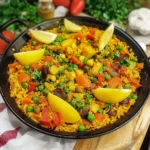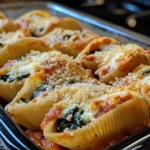There are dishes that you eat, and then there are dishes that you experience. For me, authentic Spanish paella falls firmly into the latter category. I’ll never forget my first time: a bustling Sunday afternoon on a sun-drenched terrace in Valencia, the air thick with the scent of saffron, smoke, and the sea. A massive, shallow pan—a paellera—was presented at the center of the table, a communal masterpiece brimming with golden-hued rice. The most prized part, I was told, was the socarrat, the layer of crispy, toasted rice at the bottom of the pan, which everyone scraped at with their spoons. When I decided to embrace a more plant-based lifestyle, I feared I would have to leave this magical experience behind. My initial attempts at a vegetarian version were deeply disappointing; they were little more than rice pilafs, a sad medley of vegetables stirred into rice. They lacked the soul, the depth of flavor, and most importantly, the socarrat. This recipe is the culmination of a long, delicious journey to recapture that Valencian magic without the meat. It’s a dish built on technique, not just ingredients. It’s about creating a rich, savory flavor base, using the right kind of rice, and, crucially, respecting the paella-making process. The first time I successfully made this for my family, the reaction was everything I had hoped for. The incredible aroma filled the house, and when I brought the pan to the table and we heard that signature scrape of the spoon against the crispy bottom, I knew I had finally done it. This isn’t just “rice with vegetables”; this is a true Vegetarian Paella, a vibrant, celebratory dish worthy of any Spanish Sunday.
The Ultimate Spanish Vegetarian Paella (Paella de Verduras)
This recipe is a deep dive into the art of making an authentic Paella de Verduras. We will focus on the fundamental techniques that separate a genuine paella from a simple rice dish, from building the sofrito to achieving the coveted socarrat.
Complete Ingredients List
The quality of your ingredients is paramount in a dish as beautifully simple as paella. We’ve broken them down into their functional groups.
The Core Components (The Heart and Soul):
- 2 cups (approx. 400g) Spanish Paella Rice (Bomba or Calasparra): This is the single most important ingredient. These short-grain rice varieties are prized for their ability to absorb three times their volume in liquid without bursting or becoming creamy. This is what keeps the grains distinct and firm. Do not substitute with Arborio, basmati, or jasmine rice if you want an authentic result.
- 6-7 cups High-Quality Vegetable Broth: The flavor of your broth will be the flavor of your paella. Use the best you can find, or make your own.
- A generous pinch of Saffron Threads (about 1/2 teaspoon): The “red gold” of spices. Saffron imparts the iconic golden color and a unique, earthy, and floral aroma that is irreplaceable.
- 2 teaspoons Smoked Sweet Paprika (Pimentón Dulce): Another pillar of Spanish cuisine. It adds a deep, smoky flavor and rich color. Do not use regular or hot paprika.
The Sofrito (The Flavor Foundation):
- 1/4 cup Extra Virgin Olive Oil: Use a good quality Spanish olive oil if possible.
- 1 large Spanish Onion (or Yellow Onion), finely diced
- 1 Red Bell Pepper, finely diced
- 4-5 cloves Garlic, minced
- 1 cup Grated Ripe Tomatoes (about 2-3 large Roma tomatoes): To grate, simply halve the tomatoes and grate them on the large holes of a box grater, discarding the skins. This creates a fresh tomato pulp that melts into the base.
The Vegetables (The Stars of the Show):
- 1 cup Fresh or Frozen Green Beans, trimmed and cut into 1-inch pieces
- 1 cup quartered Artichoke Hearts (canned or frozen and thawed work well)
- 1 jar (7 oz) Roasted Red Peppers, drained and sliced into strips
- 1 cup sliced Cremini Mushrooms: For a savory, umami depth.
- 1/2 cup Frozen or Fresh Peas (to be added at the end)
For Garnish and Serving:
- 1 Lemon, cut into wedges
- Fresh Parsley, chopped
Step-by-Step Instructions
Making paella is a process, a ritual. Follow these steps closely, and don’t rush. The pan is your stage.
Step 1: Prepare the Saffron Broth
- In a medium saucepan, gently warm your 6-7 cups of vegetable broth over low heat. It should be hot but not boiling when you add it to the rice.
- Crumble the saffron threads between your fingers and add them to the warm broth. Let the saffron “bloom” in the warm liquid for at least 15 minutes. This will release its full color and aroma.
Step 2: Build the Sofrito (The Flavor Base)
- Place your paella pan (or a large, wide, flat-bottomed skillet) over medium heat. Add the olive oil.
- Once the oil is shimmering, add the diced onion and red bell pepper. Sauté for 8-10 minutes, stirring occasionally, until they are very soft and sweet.
- Add the green beans and artichoke hearts to the pan. Cook for another 5 minutes, allowing them to brown slightly.
- Stir in the sliced mushrooms and cook until they have released their liquid and started to brown, about 5-7 minutes.
- Push the vegetables to the outer edges of the pan, creating a well in the center. Add a little more olive oil if needed, then add the minced garlic to the center. Cook for 30-60 seconds until fragrant, being careful not to let it burn.
- Stir the garlic into the vegetables, then add the grated tomato pulp to the pan. Cook, stirring, until the tomato has darkened in color and the liquid has evaporated, forming a thick, jammy paste. This is your sofrito.
- Sprinkle the smoked paprika over the sofrito and stir for 30 seconds to toast the spice and release its aroma.
Step 3: Add the Rice and Liquid
- Pour the 2 cups of Bomba or Calasparra rice into the pan over the sofrito. Stir it constantly for 1-2 minutes, coating every grain in the flavorful oil and sofrito. This toasting step helps the rice absorb the liquid evenly.
- Pour in the hot saffron-infused broth. Give everything one final, gentle stir to distribute the rice and vegetables evenly across the pan.
- THIS IS THE MOST IMPORTANT RULE: From this point forward, DO NOT STIR THE RICE AGAIN. Shaking the pan gently is okay, but stirring will release the starches from the rice and make it creamy like a risotto, which is the opposite of what you want.
Step 4: The Simmer and the “Reposo”
- Bring the liquid to a strong simmer, then reduce the heat to maintain a gentle, steady simmer across the entire surface of the pan. If you’re on a stove where the burner is smaller than the pan, you’ll need to rotate the pan every few minutes to ensure even cooking.
- Let it simmer gently for about 10 minutes. At this point, most of the broth should be absorbed, and you’ll see little “craters” forming in the rice.
- Arrange the strips of roasted red pepper on top of the rice and scatter the peas over the surface. Do not stir them in.
- Continue to simmer for another 8-10 minutes, or until the liquid has been almost completely absorbed. The rice should be al dente.
Step 5: Achieve the Socarrat
- Once the liquid is gone, you can achieve the coveted crispy bottom. Turn the heat up to medium-high for 60-90 seconds.
- Listen closely. You will hear the rice start to crackle and pop. It will smell toasty. This is the sound of the socarrat forming. Be brave, but be careful not to let it burn.
- Remove the pan from the heat.
Step 6: The Final Rest
- Cover the paella pan loosely with a clean kitchen towel or aluminum foil.
- Let the paella rest off the heat for 5-10 minutes. This mandatory “reposo” allows the rice to finish cooking in its own steam and the flavors to settle.
- Garnish with fresh parsley, present the pan at the table, and serve with lemon wedges for squeezing over each portion.
The Socarrat: The Soul of the Paella
For Spaniards, the socarrat is the most prized part of the paella. It is the layer of toasted, crispy, and slightly caramelized rice that forms on the bottom of the pan. It’s savory, crunchy, and intensely flavorful. Achieving it is a mark of a well-made paella. Here’s how you guarantee it:
- The Right Pan: A traditional, thin paella pan (a paellera) is designed for this. Its wide, shallow shape encourages rapid liquid evaporation and maximum contact between the rice and the hot pan bottom.
- The “No-Stir” Rule: Stirring releases starch, which creates creaminess and prevents the bottom layer from toasting. You must resist the urge to stir.
- The Final Blast of Heat: The crucial step of turning up the heat for the last minute of cooking is what transforms the bottom layer of rice from simply cooked to perfectly crispy. Use your ears—the crackling sound is your guide.
Nutrition Facts
- Servings: 4-6 generous main-course servings
- Calories per serving: Approximately 450-550 kcal (This is an estimate and will vary based on the exact amount of oil and vegetables used.)
Preparation Time
- Active Time: 45-50 minutes
- Inactive Time (Simmering & Resting): 30 minutes
- Total Time: Approximately 1 hour and 20 minutes
How to Serve Paella Like a Spaniard
Paella is more than food; it’s a social event. Serving it correctly is part of the experience.
- The Centerpiece: The paella should be brought directly to the table in the pan it was cooked in and placed in the center for everyone to admire.
- Lemon is Essential: Always serve with fresh lemon wedges. A squeeze of lemon juice over the paella just before eating brightens all the flavors.
- Serve Directly from the Pan: Traditionally, guests eat directly from the pan with their own spoons, working from the outside edge toward the center. For a more formal setting, serve individual portions onto plates, making sure everyone gets a bit of the crispy socarrat from the bottom.
- Perfect Pairings:
- Wine: A crisp Spanish white wine like an Albariño or Verdejo, or a light Spanish rosé (rosado) is a perfect match.
- Salad: A simple green salad with a light vinaigrette is all you need on the side.
- Bread: Crusty bread to mop up any remaining flavorful bits is always welcome.
Additional Tips for Paella Perfection
- The Pan is Important: If you don’t have a paella pan, use the widest, flattest, and largest skillet you own. A 12-inch or 14-inch carbon steel or cast-iron skillet is a good alternative. Avoid non-stick pans if you want to develop a good socarrat.
- Respect the Rice-to-Liquid Ratio: The general rule for paella rice is a 1:3 ratio of rice to liquid by volume. I suggest starting with 6 cups of broth for 2 cups of rice, and having an extra cup of hot broth on hand only if the rice looks too dry before it’s cooked.
- Customize Your Vegetables Wisely: Feel free to add other vegetables, but add them at the right time. Harder vegetables like carrots or cauliflower should be added with the onions. Softer vegetables like zucchini or asparagus spears can be added about halfway through the simmering process.
- Embrace the Even Heat Challenge: If cooking on a standard electric or gas stovetop, your burner will be much smaller than your pan. To combat this, you must rotate the pan a quarter turn every 2-3 minutes during the simmering stage to ensure all parts of the paella cook evenly.
- Let it Rest (Reposo): Do not skip the final 5-10 minute rest. This is not optional. The residual steam trapped under the cover is essential for finishing the cooking process and allowing the top layer of rice to become perfectly tender.
Frequently Asked Questions (FAQ)
1. Can I use Arborio (risotto) rice? What’s the difference?
You can, but it will not be paella. Arborio rice is cultivated to be high in amylopectin starch, which it releases during cooking to create the creamy, bound-together texture of risotto. Paella rice (Bomba/Calasparra) is low in this starch and is prized for staying firm and separate while absorbing huge amounts of flavor. Using Arborio rice will result in a sticky, creamy dish.
2. My paella turned out mushy. What did I do wrong?
This is a common problem with a few likely culprits: 1) You Stirred It: Stirring releases starch and creates a creamy, mushy texture. 2) Wrong Rice: You used a high-starch rice like Arborio instead of Spanish paella rice. 3) Too Much Liquid: Your rice-to-liquid ratio was off. 4) You Covered It Too Early: Covering the pan during the main simmer traps too much steam and boils the rice instead of allowing the liquid to evaporate.
3. Can I make this recipe vegan?
Yes! This recipe as written is naturally vegan. Just ensure your vegetable broth and any other packaged goods are certified vegan.
4. I can’t find saffron. Is there a substitute?
There is no true substitute for the unique flavor of saffron. However, if you absolutely cannot find it or it’s out of your budget, you can mimic the color by adding 1/2 teaspoon of turmeric to the broth. To help compensate for the flavor loss, you can increase the smoked paprika slightly. It will still be a delicious smoky vegetable rice dish, but it won’t have the classic paella taste.
5. How do I clean a paella pan?
After everyone has scraped out the last bits of socarrat, fill the pan with hot water and a little dish soap and let it soak. This will loosen any stubborn, stuck-on rice. For traditional carbon steel pans, after washing and drying them completely (you can even place them on the stove for a moment to ensure all moisture is gone), wipe the inside with a very thin layer of cooking oil on a paper towel. This seasons the pan and prevents it from rusting.

Spanish Vegetarian Paella recipe
Ingredients
The Core Components (The Heart and Soul):
-
2 cups (approx. 400g) Spanish Paella Rice (Bomba or Calasparra): This is the single most important ingredient. These short-grain rice varieties are prized for their ability to absorb three times their volume in liquid without bursting or becoming creamy. This is what keeps the grains distinct and firm. Do not substitute with Arborio, basmati, or jasmine rice if you want an authentic result.
-
6-7 cups High-Quality Vegetable Broth: The flavor of your broth will be the flavor of your paella. Use the best you can find, or make your own.
-
A generous pinch of Saffron Threads (about 1/2 teaspoon): The “red gold” of spices. Saffron imparts the iconic golden color and a unique, earthy, and floral aroma that is irreplaceable.
-
2 teaspoons Smoked Sweet Paprika (Pimentón Dulce): Another pillar of Spanish cuisine. It adds a deep, smoky flavor and rich color. Do not use regular or hot paprika.
The Sofrito (The Flavor Foundation):
-
1/4 cup Extra Virgin Olive Oil: Use a good quality Spanish olive oil if possible.
-
1 large Spanish Onion (or Yellow Onion), finely diced
-
1 Red Bell Pepper, finely diced
-
4-5 cloves Garlic, minced
-
1 cup Grated Ripe Tomatoes (about 2-3 large Roma tomatoes): To grate, simply halve the tomatoes and grate them on the large holes of a box grater, discarding the skins. This creates a fresh tomato pulp that melts into the base.
The Vegetables (The Stars of the Show):
-
1 cup Fresh or Frozen Green Beans, trimmed and cut into 1-inch pieces
-
1 cup quartered Artichoke Hearts (canned or frozen and thawed work well)
-
1 jar (7 oz) Roasted Red Peppers, drained and sliced into strips
-
1 cup sliced Cremini Mushrooms: For a savory, umami depth.
-
1/2 cup Frozen or Fresh Peas (to be added at the end)
For Garnish and Serving:
-
1 Lemon, cut into wedges
-
Fresh Parsley, chopped
Instructions
Step 1: Prepare the Saffron Broth
-
In a medium saucepan, gently warm your 6-7 cups of vegetable broth over low heat. It should be hot but not boiling when you add it to the rice.
-
Crumble the saffron threads between your fingers and add them to the warm broth. Let the saffron “bloom” in the warm liquid for at least 15 minutes. This will release its full color and aroma.
Step 2: Build the Sofrito (The Flavor Base)
-
Place your paella pan (or a large, wide, flat-bottomed skillet) over medium heat. Add the olive oil.
-
Once the oil is shimmering, add the diced onion and red bell pepper. Sauté for 8-10 minutes, stirring occasionally, until they are very soft and sweet.
-
Add the green beans and artichoke hearts to the pan. Cook for another 5 minutes, allowing them to brown slightly.
-
Stir in the sliced mushrooms and cook until they have released their liquid and started to brown, about 5-7 minutes.
-
Push the vegetables to the outer edges of the pan, creating a well in the center. Add a little more olive oil if needed, then add the minced garlic to the center. Cook for 30-60 seconds until fragrant, being careful not to let it burn.
-
Stir the garlic into the vegetables, then add the grated tomato pulp to the pan. Cook, stirring, until the tomato has darkened in color and the liquid has evaporated, forming a thick, jammy paste. This is your sofrito.
-
Sprinkle the smoked paprika over the sofrito and stir for 30 seconds to toast the spice and release its aroma.
Step 3: Add the Rice and Liquid
-
Pour the 2 cups of Bomba or Calasparra rice into the pan over the sofrito. Stir it constantly for 1-2 minutes, coating every grain in the flavorful oil and sofrito. This toasting step helps the rice absorb the liquid evenly.
-
Pour in the hot saffron-infused broth. Give everything one final, gentle stir to distribute the rice and vegetables evenly across the pan.
-
THIS IS THE MOST IMPORTANT RULE: From this point forward, DO NOT STIR THE RICE AGAIN. Shaking the pan gently is okay, but stirring will release the starches from the rice and make it creamy like a risotto, which is the opposite of what you want.
Step 4: The Simmer and the “Reposo”
-
Bring the liquid to a strong simmer, then reduce the heat to maintain a gentle, steady simmer across the entire surface of the pan. If you’re on a stove where the burner is smaller than the pan, you’ll need to rotate the pan every few minutes to ensure even cooking.
-
Let it simmer gently for about 10 minutes. At this point, most of the broth should be absorbed, and you’ll see little “craters” forming in the rice.
-
Arrange the strips of roasted red pepper on top of the rice and scatter the peas over the surface. Do not stir them in.
-
Continue to simmer for another 8-10 minutes, or until the liquid has been almost completely absorbed. The rice should be al dente.
Step 5: Achieve the Socarrat
-
Once the liquid is gone, you can achieve the coveted crispy bottom. Turn the heat up to medium-high for 60-90 seconds.
-
Listen closely. You will hear the rice start to crackle and pop. It will smell toasty. This is the sound of the socarrat forming. Be brave, but be careful not to let it burn.
-
Remove the pan from the heat.
Step 6: The Final Rest
-
Cover the paella pan loosely with a clean kitchen towel or aluminum foil.
-
Let the paella rest off the heat for 5-10 minutes. This mandatory “reposo” allows the rice to finish cooking in its own steam and the flavors to settle.
-
Garnish with fresh parsley, present the pan at the table, and serve with lemon wedges for squeezing over each portion.
Nutrition
- Serving Size: one normal portion
- Calories: 450-550 kcal





